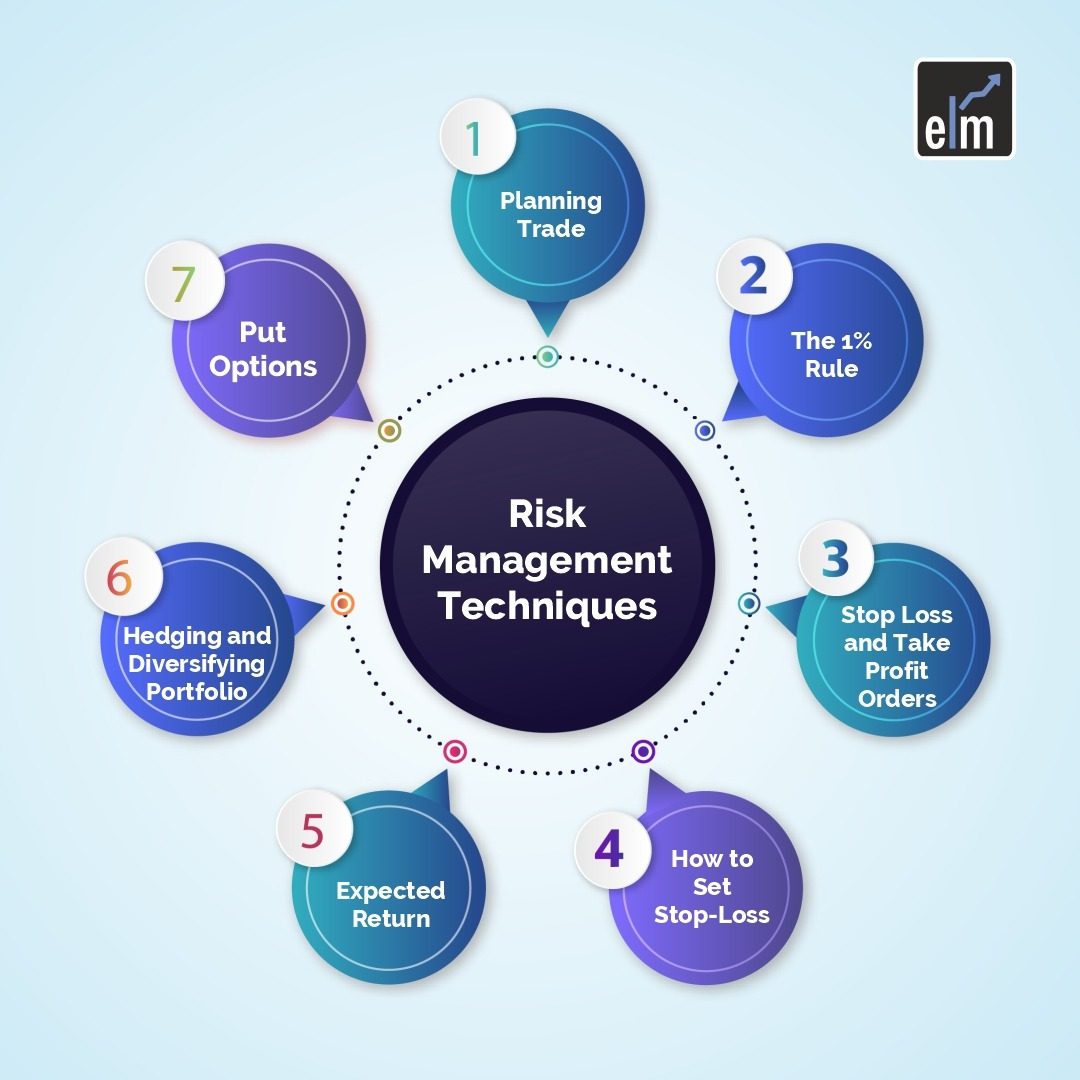Losses are reduced with the aid of risk management. Additionally, it can prevent traders’ accounts from losing their funds. When traders lose money, there is a risk. Traders have the potential to profit in the market if they can manage their risk.
It is a crucial but frequently disregarded requirement for effective active trading. After all, without a sound risk management plan, a trader who has made sizable profits could lose it all in just one or two bad trades. So how do you create the best methods to reduce market risks?
In today’s blog, we will go over a few easy methods you can employ to safeguard your trading profits.
7 Risk Management Strategies

1. Planning Trade
According to the renowned Chinese military general Sun Tzu, “Every battle is won before it is fought.” This expression implies that wars are won through planning and strategy rather than through actual combat.
Similar to this, successful traders often say, “Plan the trade and trade the plan.” Similar to how planning ahead can make the difference between success and failure in battle.
Take profit and stop loss orders are two important ways that traders can plan ahead when trading. Successful traders are aware of the prices they are willing to buy and sell items for.
They can then compare the resulting returns to the likelihood that the stock will achieve its objectives. They close the trade if the adjusted return is high enough.
On the other hand, unsuccessful traders frequently start a trade with no idea of the points at which they will sell for a profit or a loss. Emotions start to take control and direct their trades, much like lucky—or unlucky—streak gamblers.
Losses frequently compel people to hang on in the hopes of recovering their money, whereas gains may tempt traders to unwisely hold on for additional gains.
2. The 1% Rule
Many day traders adhere to what is known as the 1% rule. In essence, this rule of thumb advises against investing more than 1% of your capital or trading account in a single transaction.
Therefore, if you have Rs. 10,000 in your trading account, you shouldn’t have more than Rs. 100 invested in any one instrument.
For traders with accounts under $100,000, this tactic is typical; some even increase it to 2% if they can. Many traders may decide to use a lower percentage if their accounts have higher balances.
That’s because the position grows in proportion to the size of your account. The best way to limit your losses is to keep the rule below 2%; if you go over that, you run the risk of losing a significant portion of your trading account.
3. Stop Loss and Take Profit Orders
The price at which a trader will sell a stock and take a loss on the transaction is known as a stop loss point. This frequently occurs when a trade does not turn out as a trader had hoped.
The points are intended to stop the belief that “it will come back” and to stop losses before they get out of control. For instance, traders frequently sell a stock as soon as they can if it breaks below a crucial support level.
A take-profit point, on the other hand, is the cost at which a trader will sell a stock and profit from the transaction.
At this point, the potential upside is constrained by the inherent dangers. For instance, traders might want to sell a stock if it is nearing a crucial resistance level after making a significant upward move before a period of consolidation begins.
4. How to set Stop Loss
Technical analysis is frequently used to determine stop loss and take-profit levels, but fundamental analysis can also be very important for timing.
For instance, if anticipation is high for a stock that a trader is holding ahead of earnings, the trader might want to sell the stock before the news is announced if expectations have risen too much, regardless of whether the take-profit price has been reached.
Because they are simple to calculate and closely monitored by the market, moving averages are the most widely used method of determining these points. The 5, 9, 20, 50, 100, and 200-day averages are important moving averages.
The best way to determine these is to apply them to a stock’s chart and see how the price of the stock has responded to them in the past as either a support level or a resistance level.
On support or resistance trend lines, stop-loss or take-profit levels can also be placed. These can be formed by joining prior highs or lows that happened on a significant amount of volume above the norm.
The key, just like with moving averages, is figuring out at what points the price responds to trend lines and, of course, on high volume.
You can refer to or capital market course to learn more about the stopploss placement and price action.
5. Expected Return
To determine the expected return, stop-loss and take-profit points must also be established. It is impossible to overstate the significance of this calculation because it compels traders to carefully consider and justify their trades.
Additionally, it provides them with a methodical way to evaluate different trades and pick only the most successful ones.
The formula below can be used to calculate this:
[(Probability of Gain) x (Take Profit % Gain)] + [(Probability of Loss) x (Stop-Loss % Loss)]
For the active trader, the outcome of this calculation is an expected return, which they will compare to other opportunities to decide which stocks to trade.
The historical breakouts and breakdowns from the support or resistance levels can be used to calculate the probability of gain or loss; for seasoned traders, an educated guess can also be used.
6. Hedging and Diversifying Portfolio
Never put all of your trading eggs in one basket to ensure that you get the most out of it. You’re setting yourself up for a significant loss if you invest all your funds in a single stock or financial instrument.
Therefore, keep in mind to diversify your holdings across industry sectors, market capitalization, and geographic regions. This increases your opportunities while also assisting you in managing your risk.
Additionally, you might come across a situation where you need to hedge your position. When the results are due, think about taking a stock position. Through options, you might think about adopting the opposing stance to help defend your position. You can unwind the hedge once trading activity slows down.
You can also join our course NSE Academy Certified Capital Market Professional (E-NCCMP)
7. Put Options
Purchasing a downside put option, also referred to as a protective put, if you are authorised to trade options, can be used as a hedge to limit losses from a trade that goes south. With a put option, you have the option but not the obligation to sell the underlying stock at a predetermined price at the option’s expiration or before.
Bottomline
Before executing a trade, traders should always know when they intend to enter or exit it. A trader can reduce losses and the number of times a trade is needlessly exited by using stop losses effectively. Make your battle strategy in advance so that you can already know when the war is over.
We hope you found this blog informative and use the information to its maximum potential in the practical world. Also, show some love by sharing this blog with your family and friends and helping us spread financial literacy.
Happy Investing!
To get the latest updates about Financial Markets, visit StockEdge






